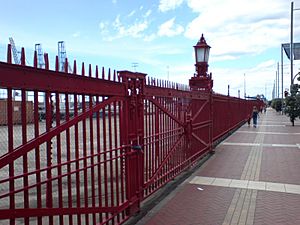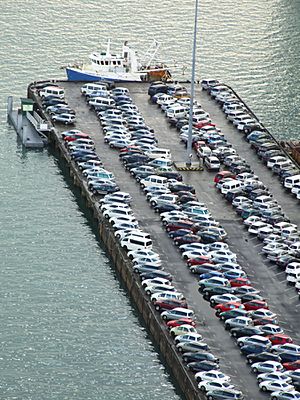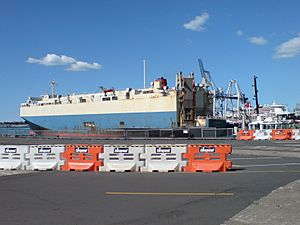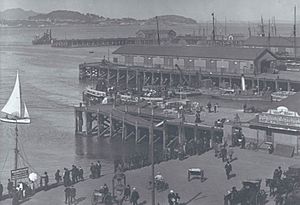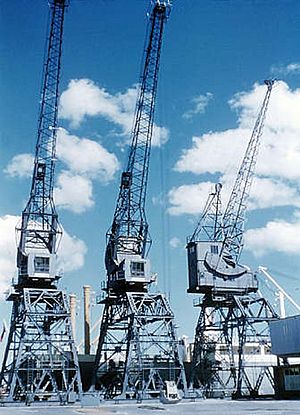Port of Auckland facts for kids
Quick facts for kids Port of Auckland |
|
|---|---|
 |
|
| Location | |
| Country | New Zealand |
| Location | Waitematā Harbour |
| Coordinates | 36°50′38″S 174°46′37″E / 36.843774°S 174.776859°E |
| Details | |
| Opened |
|
| Operated by | Auckland Council |
| Owned by | Auckland Council (100%) |
| Available berths | 17 |
| Wharfs | 8 |
| Draft depth | 13.0 metres (42.7 ft) |
| Employees |
|
| Statistics | |
| Vessel arrivals | 1,200 |
| Annual cargo tonnage | 2,000,000 (excluding Ro-Ro) |
| Annual container volume | 845,000 TEU |
| Passenger traffic | 335,000 (cruise) |
| Annual cruise ship visits | 130 |
| Annual Cars | 208,000 (Ro-Ro) |
The Port of Auckland Limited (often called POAL) is a company that manages Auckland's main port. This port handles commercial cargo and welcomes cruise ships. It is owned by the Auckland Council. The company runs all the port facilities in the Greater Auckland area. This article talks about both the company and the ports themselves.
Contents
How the Port Works
Port of Auckland Limited operates a large seaport on the Waitematā Harbour. It also has four inland freight hubs. These hubs are located in South Auckland, Palmerston North, Mount Maunganui, and the Waikato region. The company has about 600 full-time staff. They work all day and night to quickly move cargo. The port used to have another seaport at Onehunga on the Manukau Harbour, but this port closed in the 2010s.
Auckland's Main Port
The Port of Auckland is a major port for containers and international trade. It is located on the Waitematā Harbour, right next to central Auckland. The port covers 55 hectares (about 136 acres) of wharves and storage areas. Most of this land was created by filling in parts of the sea. This happened in areas that used to be called Commercial Bay, Official Bay, and Mechanics Bay.
In 2023, the company officially changed its name from "Ports of Auckland" to "Port of Auckland." This change shows that it now mainly operates one large seaport on the Waitematā Harbour. The Onehunga seaport was sold in 2018.
The main wharves at the port, from west to east, include:
- Wynyard Wharf: This area was once used for storing chemicals. It is now being turned into a new area with homes and parks.
- Princes Wharf: This wharf has homes and is also a terminal for cruise ships.
- Queens Wharf: This wharf is planned to be another cruise ship terminal.
- Captain Cook Wharf
- Marsden Wharf
- Bledisloe Wharf
- Jellicoe Wharf
- Freyberg Wharf
- Fergusson Wharf: This is a very large area created in the 1960s for container trade.
In 2018, three new, very large container cranes arrived from China. Each crane cost NZ$20 million. They are now at the Fergusson Container Terminal. These cranes are the biggest in New Zealand, weighing 2,100 tonnes each. They stand 114 metres (374 feet) high and can reach 70 metres (230 feet). They can lift four 20-foot containers at once. These cranes help the port handle very large ships. Each crane also has enough solar panels to power an average New Zealand home.
Port of Auckland Limited aims to have Zero Emissions by 2040. In 2021, they received the world's first full-size, fully electric port tug. This new tug is as strong as the port's most powerful diesel tug.
The Former Port of Onehunga
There was a smaller port at Onehunga on the Manukau Harbour. This port was closer to the industrial areas of South Auckland. However, it was less important than the main port. This was because the entrance to the Manukau Harbour was shallow, and the facilities were smaller. It was mostly used for shipping goods within New Zealand.
The Onehunga port was very busy in the 1850s and early 1860s. It connected to the Waikato regions. Local Māori tribes would trade goods like peaches, fish, and potatoes there. This trade stopped in 1863. Over time, the port was used less as new roads and railways were built.
Modern ships became too big for the Onehunga port. In 2018, Port of Auckland sold Onehunga Wharf to Panuku Development Auckland. This council group plans to develop the area.
Chelsea Wharf
Chelsea Wharf is in Birkenhead on the North Shore. It is not part of the Port of Auckland's facilities. This wharf serves the Chelsea Sugar Refinery, which has been operating since 1884. Ships carrying unrefined sugar arrive at the wharf about every six weeks. These ships are large and need special guidance from port pilots.
Inland Ports
The four inland ports operated by Port of Auckland help move goods. They act as transfer points between the main seaport and the national road and rail networks. This helps freight move smoothly across the country.
How Much Trade Happens?
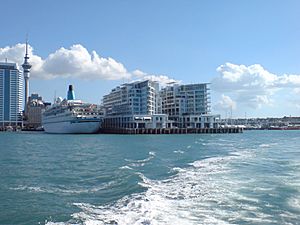
Freight Movement
Auckland is New Zealand's largest commercial port. About 1,600 commercial ships visit it each year. It handles over NZ$20 billion worth of goods annually. The Port of Auckland moves 60% of New Zealand's imports and 40% of its exports by value. It also handles about 37% of all New Zealand's container trade. Each year, it moves 4 million tonnes of other cargo and around 773,160 twenty-foot equivalent containers.
Another major import is used cars. About 250,000 used cars arrive each year. These cars are mostly newer Japanese models. New Zealand has very strict rules about keeping out pests and diseases. These rules are managed by the MPI. Because of these rules, cars and many other goods must go through a cleaning process. This can make the process take longer.
Cruise Ship Visits
The Port of Auckland is also a popular stop for cruise ships. In the 2005/2006 season, 48 cruise ships visited, bringing over 100,000 passengers. Most passengers disembark for short trips around Auckland. Each cruise ship visit is estimated to add about NZ$1 million to the local economy. In 2007/2008, the number of visits increased to 73.
The largest ship to visit so far was the Queen Mary 2. It had to use a different wharf because of its huge size. In February 2007, the port had its busiest day for cruise passengers. Two ships, the Statendam and Sapphire Princess, exchanged about 8,000 people. This was like 19 Boeing 747 jumbo jets arriving at once.
In 2013, Auckland won an award for being the "Best Turnaround Destination." This means it was recognized as the best place to start or end a cruise trip.
Port's Impact on the Economy
The Port of Auckland is very important for the economy. About 173,000 jobs in the Auckland Region depend on trade through the port. The port affects about one-third of the local economy. Since 2005, the port has been 100% owned by the Auckland Council. It has paid over NZ$500 million in dividends to the council and its earlier groups.
Port History
Auckland is a city on an island, so its trade has always relied on its harbours. The port started with wharves in Commercial Bay in the 1840s. It grew through large land reclamation projects that changed the Auckland waterfront over many years. The port became the largest in New Zealand by 1924.
19th Century Developments
The first harbour facilities in Commercial Bay and Official Bay were hard to build because of muddy areas. In 1853, the Auckland Provincial Council took control of the Waitematā Harbour. They worked to improve the port, building the first Queen Street Wharf and a quay along Customs Street.
In 1871, the Auckland Harbour Board was created. More wharves were added, and huge land reclamation projects took place. This meant that areas like Freemans Bay and Mechanics Bay lost their natural shorelines. Commercial Bay, where much of central Auckland is today, was completely filled in. The new land allowed for railway wharves and new dockyard facilities. On the other side of the harbour, in Devonport, the 'Calliope Dock' was built in 1888. It was the largest drydock in the Southern Hemisphere at the time.
20th Century Growth
By the early 1900s, the port was very busy with ships carrying goods and passengers. During World War II, the United States used Auckland as a base for its fleet. This led to the port expanding even more. In 1943, 104 warships and 284 transport ships visited Auckland. The port began operating 24 hours a day, 7 days a week.
After the war, the port continued to grow. The Import and Freyberg Wharves opened in 1961. The Overseas Passenger Terminal was built on Princess Wharf. In the late 1960s, the large Fergusson Wharf was created to handle the new trend of container shipping. It was finished in 1971, and the first container ship arrived in 1973.
In 1985, a teenager managed to get into the Harbour Board's computer system. This was one of the first hacking incidents reported in New Zealand.
Becoming a Company
In 1988, the Auckland Harbour Board became a company called Ports of Auckland. This change helped the port become more efficient. However, it also meant fewer people were directly employed by the port.
In 1993, 20% of the company's shares were sold to the public. In 2005, the Auckland Regional Council bought back all the shares. This made the port 100% owned by the council. Since 2019, the Auckland Council directly manages its ownership of Ports of Auckland Limited.
21st Century Changes
Today, the Port of Auckland is the third largest container terminal in Australia and New Zealand. It is also New Zealand's busiest port. The port continues to expand and change. There are plans to move some harbour operations further east to make the Auckland waterfront more open to the public.
In 2007, the port considered merging with the Port of Tauranga, but this did not happen. In the same year, the amount of goods handled by the port increased by 12.6%.
In 2008, the port planned to combine the Fergusson and Bledisloe terminals. This would create a larger area for handling containers. The goal was to increase the port's capacity by 250%. This would allow ships carrying up to 7,000 containers to use the port. The plan included buying even larger cranes and stacking containers higher.
In 2009, the port saw an increase in container business. However, there was a big drop in car imports due to an economic slowdown. This reduced the company's profits.
Since 2010, Ports of Auckland has operated a new inland port in Wiri. This facility connects road freight to the port using trains. This helps reduce the number of trucks traveling through central Auckland by up to 100,000 trips a year.
In August 2020, a worker was killed in an accident involving a falling container. In December 2023, Port of Auckland was ordered to pay $561,000, along with $90,000 to Maritime New Zealand. There were also other incidents in April 2022.
On May 7, 2024, the Mayor of Auckland, Wayne Brown, decided not to sell the Port of Auckland. Instead, the Auckland Council will keep ownership of the port lands, assets, and operations. The port also agreed to return Captain Cook Wharf and Marsden Wharf to the Auckland Council. They also promised to give the public more access to Bledisloe Wharf. The council and Eke Panuku Development Auckland are now planning how to redevelop Auckland's waterfront.
Worker Disputes
In late 2011, Ports of Auckland had a disagreement with its workers. The workers were part of the Maritime Union of New Zealand. The dispute was about new contracts and the port's plan to use more temporary workers. The port said it needed to be more flexible to compete with other ports. Other port workers in New Zealand briefly stopped work to support the Auckland workers.
In March 2012, the Port announced that all striking dock workers would lose their jobs. This caused a strong reaction from the union and its international partners. On March 9, the International Transport Workers' Federation declared Ports of Auckland a "port of convenience." This means they believed the port was trying to avoid fair labor practices.
A protest march was held in Auckland on March 10, with thousands of people attending. The Port then published a letter saying that port workers earned a high average salary for a short work week. The union disagreed with these figures.
The Mayor of Auckland, Len Brown, offered to help resolve the dispute. In December 2012, the Port was fined NZD$40,000 for hiring temporary workers during the strike. A new agreement was finally reached in February 2015.
SeePort Open Weekend
Ports of Auckland holds an annual open weekend called SeePort. This event takes place on Auckland Anniversary Weekends. It allows the public to visit the port and learn about Auckland's shipping history and maritime heritage.
See also
 In Spanish: Puertos de Auckland para niños
In Spanish: Puertos de Auckland para niños
- Auckland Harbour Board v CIR




